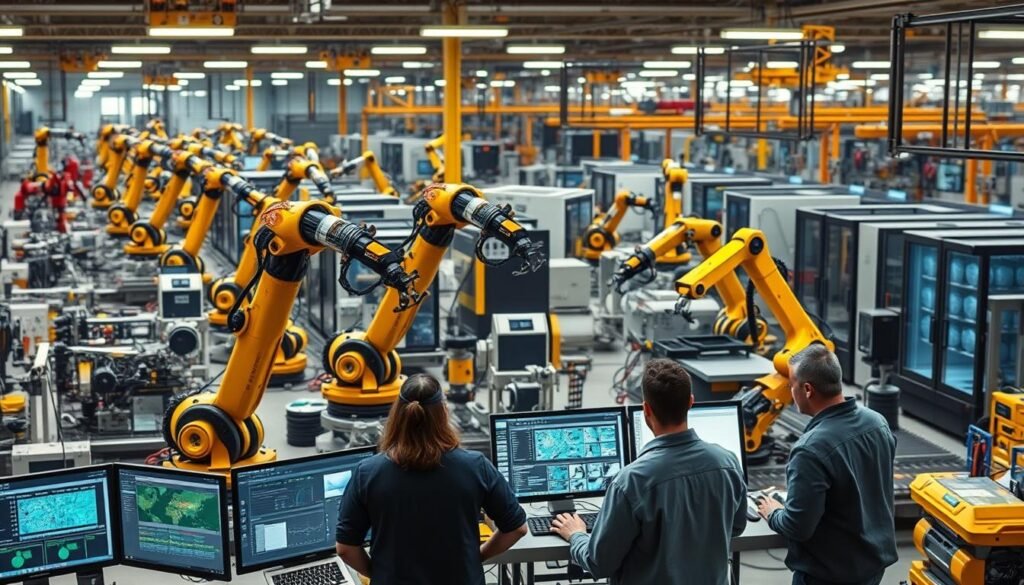Navigating the Automated Workforce: The Future of Work Revealed
Did you know that by 2030, automation could displace up to 375 million workers globally, according to McKinsey & Company? As we look ahead, we face both the amazing possibilities and the big challenges of automation. Artificial intelligence and machine learning are changing jobs and the economy fast.
Experts like Erik Brynjolfsson say we should use technology to help humans, not replace them. He believes in working together with machines. But Adam Thierer thinks we shouldn’t worry too much about losing jobs. He says automation can actually create new work opportunities.
We’re going to explore the trends in automated work and how it affects jobs. We’ll also look at how these changes will shape our future. This journey will show us both the good and the bad sides of this new technology.
Key Takeaways:
- By 2030, automation could displace up to 375 million workers globally.
- Technological advancements offer both incredible and significant challenges.
- Erik Brynjolfsson supports technology that enhances human capabilities.
- Adam Thierer argues against pessimistic forecasts concerning automation-induced unemployment.
- Understanding automated workforce trends is key to preparing for the future of work.
Introduction to the Automated Workforce
Businesses today face many challenges, and workforce automation is key to solving them. It changes how we do tasks and improve productivity. From the start of machines to today’s robotic process automation, we keep looking for better ways to work.
The Evolution of Workforce Automation
The story of workforce automation is long and interesting. It began with the First Industrial Revolution and machines helping humans. This was the start of making work easier with technology.
The digital age in the late 20th century really boosted automation. Computers and the internet helped robotic process automation grow. Now, AI in workforce management is taking it even further, making complex tasks easier for machines.
Key Drivers of Automation in the Workplace
Many things are making workforce automation more popular. New technology is a big reason, giving us better ways to work. Also, saving money with automation is very appealing to businesses.
Companies want to use robotic process automation and AI in workforce to keep up in a global market. These tools help cut costs and improve work, letting businesses focus on new ideas and growth.
Historical Perspectives on Workforce Automation
Looking back at how technology has changed the job market shows us interesting trends. From the steam engine to early computers, each new technology has changed the way we work. We explore these changes to learn from the past and prepare for today.
Past Technological Advancements and Employment Shifts
The industrial revolution was huge, introducing machines like the steam engine. These machines made work faster but took away many jobs. Later, the assembly line changed how things were made, creating new jobs but making old ones less needed.
Computers came next, making some jobs more technical and taking over simple tasks. This made work more efficient but changed what jobs were available.

Lessons Learned from Previous Industrial Revolutions
Automation’s history teaches us about the importance of being able to adapt. Every new technology brings job changes at first, but then new jobs appear in new areas. Workers often have to learn new skills to keep up.
These big changes also make work better and help the economy grow. They make us more productive and change how we work together.
| Technological Advancement | Impact on Jobs | New Opportunities |
|---|---|---|
| Steam Engine | Displacement of manual labor | Increased need for machinery operators |
| Assembly Line | Automation of manufacturing tasks | Rise of manufacturing sectors and engineering roles |
| Early Computing Machines | Reduction of repetitive clerical tasks | Growth in IT and technical support roles |
Looking at these times shows how strong and adaptable the workforce is. It also shows the good things that come from new technology. As we face today’s tech trends, these lessons help us get ready for what’s next.
The Role of AI in Workforce Management
AI has changed how companies manage their employees’ work. It helps plan schedules, tasks, and track performance. AI gives managers insights to make better decisions, improving how work gets done and who does it.
AI-Powered Workforce Management Solutions
AI solutions for managing work offer cool features like automated scheduling and real-time tracking. They also give detailed performance reports. For example, AI can forecast project success and how well employees will do. This helps managers use resources better and boost team performance.
Enhancing Productivity with AI Workforce Tools
Using AI tools in work can give employees insights tailored just for them. This can make them more engaged. These tools analyze data to suggest ways to work more efficiently. This leads to better performance and a happier team.
| Feature | Benefit |
|---|---|
| Automated Scheduling | Reduced manual errors and time savings |
| Real-Time Task Tracking | Improved task visibility and accountability |
| Predictive Analytics | Informed decision-making and resource optimization |
Economic Impact of AI and Automation
Artificial Intelligence and automation have changed many industries. They have brought big changes to the economy. Businesses are now more efficient and productive than ever before.
Productivity Gains and Economic Growth
Companies using AI and automation see big gains in productivity. This leads to more economic growth. They can make more with less cost.
Studies by the McKinsey Global Institute show a big impact. They say AI could add $13 trillion to the global economy by 2030.

| Sector | Productivity Increase (%) | Economic Growth Contribution ($ Billion) |
|---|---|---|
| Manufacturing | 22% | 2,000 |
| Healthcare | 18% | 1,500 |
| Retail | 15% | 1,200 |
| Finance | 10% | 800 |
The Debate on AI-Induced Job Displacement
The talk about AI and job loss is ongoing. Economist Daron Acemoglu points out possible issues like inequality. While some areas see gains, others face big changes in jobs.
We need to find ways to use AI wisely. We must protect jobs and keep the economy growing.
Automated Workforce: Balancing Human and Machine Collaboration
In today’s fast-changing work world, working together with machines is key. This teamwork boosts innovation and makes work more efficient. Companies that use both humans and machines are leading the way. They mix human smarts with machine precision.
Case Studies Highlighting Successful Integrations
Ford’s plants are a great example of humans and machines working together. They use robots to do repetitive tasks. This lets humans focus on more complex jobs.
Amazon’s fulfillment centers also show how well humans and machines can work together. Robots help with picking and packing. Humans check quality and handle special requests.
This teamwork makes delivery faster and improves customer happiness by cutting down on mistakes.
The Value of Augmenting Human Capabilities
Using machines to help humans brings many benefits. For example, AI tools at Salesforce help with customer service. AI sorts through lots of data, giving humans useful information.
This helps sales teams make quick, smart choices. It leads to better customer relationships and more sales.
In healthcare, machines help with tasks like scheduling and data entry. This lets doctors focus more on patients and complex medical tasks.
| Company | Industry | Human-Machine Collaboration Example | Outcome |
|---|---|---|---|
| Ford | Manufacturing | Use of cobots for repetitive tasks | Reduced production times, maintained quality |
| Amazon | eCommerce | Robotic systems for sorting and packing | Faster delivery, higher customer satisfaction |
| Salesforce | Technology | AI assistants for data insights | Improved decision-making, increased sales |
In summary, combining humans and machines makes work better. It leads to faster, smarter work and better results. By working together, companies can achieve more while keeping human creativity and problem-solving skills.
Key Industries Transforming with Workforce Automation
Looking at the world of automated workforce technology, some industries are leading the way. The industry adoption of AI has brought big changes to manufacturing, healthcare, and financial services. These areas have adopted automation to boost efficiency, cut costs, and better serve customers.
Early Adopters and Industry Leaders
Manufacturing is a key player in this change. Giants like General Electric and Siemens have brought AI into their operations. They use it for predictive maintenance and smooth production.
The healthcare sector is also making big strides. Pioneers like Boston Scientific are using robotic surgeries to change patient care.
Sector-Specific Applications of AI
In finance, AI has led to automated fraud detection systems. Big banks like JPMorgan Chase are using AI to improve security and efficiency. In healthcare, AI helps with diagnoses, making them more accurate and beneficial for patients.
In manufacturing, AI predicts when machines need maintenance. This reduces downtime and boosts productivity.
As we watch these changes, it’s clear that automated workforce technology has a huge impact. It’s setting the stage for even more innovation in the future.
Workforce Automation Technology Trends
Exploring the modernization of workforce automation is key. It’s important to grasp the trends that are changing this field. These trends are moving industries forward and reshaping the future of work.

Recent Innovations and Future Predictions
Recently, we’ve seen big steps forward in workforce automation. Robotic process automation (RPA) has changed how we do repetitive tasks. It makes things more efficient and accurate. With advanced AI analytics, companies can now analyze huge amounts of data, leading to better decisions.
Looking to the future, we expect AI to get even better. We’ll see more advanced machine learning and predictive analytics. These advancements will likely change many industries, making them more productive and opening up new business opportunities.
Challenges and Opportunities in Automation Technology
While there are many benefits, there are also challenges. Ethical concerns like data privacy and job loss are big issues. Companies need to focus on ethical AI and retraining programs to help workers adapt.
But there are also big opportunities. Automation can help businesses innovate, streamline, and enter new markets. By using the latest tech, companies can stay competitive and help the economy grow.
Understanding the current and future trends in automation is vital. As we move forward, finding a balance between challenges and opportunities will be key to success.
| Technology | Usage | Impact |
|---|---|---|
| Robotic Process Automation (RPA) | Automating repetitive tasks | Increased efficiency and accuracy |
| Advanced AI Analytics | Data analysis and decision-making | Improved insights and outcomes |
| Autonomous Operations | Independent task completion | Higher productivity and innovation |
Policy Implications of Workforce Automation
Automation is changing our economy, and we need smart policies to manage this change. We must update our policies to fit the new automated workforce. This means changing education, taxes, and supporting workers to adapt.

Required Policy Changes and Incentives
We need to rethink how we teach people. Schools should focus more on STEM and lifelong learning. Also, we should change taxes to encourage investments in people, not just tech.
Balancing Taxation and Investment in Human Capital
We must balance tech growth with worker protection. Taxes should help companies train their workers. This way, everyone benefits from automation. Laws that support worker training are key to this balance.
Automation and Workforce Development Strategies
The rise of workforce automation software has changed how we think about workforce development. It’s key for organizations and governments to update their strategies. They must prepare employees for a world driven by technology.
Continuous learning is essential. By adding new tech to education, we keep the workforce competitive. Schools should work with companies to make curriculums that meet job market needs.
Collaboration between public and private sectors is also vital. They can share resources and expertise. This helps create a workforce that can adapt quickly. They can offer training programs and support for employee development.
Organizations need a complete plan for workforce development. It should focus on today’s needs and tomorrow’s. This includes training in different areas and mentoring to make the workforce versatile.
“The future belongs to those who prepare for it today.” This famous quote highlights the need for proactive steps in workforce development.
Here’s a look at different strategies and their effects:
| Strategy | Description | Impact |
|---|---|---|
| Continuous Learning Programs | Ongoing training and development initiatives to keep skills updated. | Ensures long-term employability and adaptability. |
| Public-Private Partnerships | Collaboration between governmental bodies and private enterprises. | Enhances resource pooling and expertise sharing. |
| Tech-Centric Curriculums | Educational programs focused on current and emerging technologies. | Prepares students for the demands of an automated job market. |
| Job Rotation and Mentoring | Exposing employees to different roles and providing guidance. | Builds versatility and deepens organizational understanding. |
In conclusion, it’s critical to have good workforce development strategies. With ongoing learning, partnerships, and a forward-thinking mindset, we can keep the workforce strong and ready for the future.
The Skepticism Surrounding Automation Predictions
Automation, powered by AI, is a big topic in talks about the future of work. Many forecasts show big changes, but we should also think about skepticism in automation impact forecasts. Experts like Adam Thierer say we should be careful and look closely at these predictions.
History shows that tech predictions often don’t come true. For example, computers were once thought to make many jobs obsolete. But, they’ve actually led to more jobs and better work. This shows how hard it is to predict the impact of automation.
It’s important to remember that realistic views on AI impact include seeing the good sides. Things like better productivity and job quality are possible. But, we should look at the facts carefully, avoiding extreme views.
“The hyperbolic forecasts of mass unemployment paint a misleading picture. While automation will undoubtedly change job landscapes, history has shown us that innovation often leads to new opportunities and sectors.” – Adam Thierer
As we look ahead, our talks about automation need to be based on facts. By dealing with the doubts about automation forecasts, we can make better policies. This way, we can get ready for the real changes AI and automation will bring.
| Prediction | Outcome | Comment |
|---|---|---|
| Widespread Job Loss | Partial Realignment | New sectors emerged creating unforeseen job roles |
| Increased Productivity | Confirmed | Productivity gains evident in multiple industries |
| Workers’ Skill Obsolescence | Skill Evolution | Training programs adapted to new technological needs |
Automated HR Solutions and Their Role in the Future Workforce
Automated HR solutions are changing how companies manage their workforce. AI in HR processes helps make decisions based on data, reducing biases and improving efficiency. These changes are real and are transforming HR.
Streamlining HR Processes with Automation
Automation in HR makes many tasks easier and faster. For example, AI helps find the best candidates by analyzing lots of data. It also improves employee management and analytics, giving insights and better experiences.
Automated systems also make it easier to get feedback from employees. This helps companies keep getting better.
Benefits of Automated HR Systems
Automated HR solutions bring many benefits. They make HR work more efficient, freeing up time for important tasks. They also help make decisions based on data, making things fairer.
These systems also help personalize how companies interact with employees. This makes employees happier and more likely to stay.
Let’s look at how automated HR compares to traditional methods:
| Aspect | Traditional HR Processes | Automated HR Solutions |
|---|---|---|
| Efficiency | Time-consuming, manual | Instant, high-speed processing |
| Bias Reduction | High human error | Data-driven decisions |
| Employee Experience | Generic, limited | Personalized, engaging |
Understanding AI in HR processes shows how it’s changing HR. Automated solutions make HR more strategic and improve the employee experience. The data shows AI is key for success in the future.
The Future of Jobs and Skill Requirements
Artificial intelligence (AI) and automation are changing the workforce. They bring both challenges and opportunities. We need to know what skills will be needed in the future.
New jobs are emerging that mix old skills with new tech knowledge. This is because smart systems are being used in many fields.
Emerging Job Roles in the AI-Era
The job market is changing fast with AI and automation. New jobs are coming that need both old and new skills. For example, AI Ethics Managers focus on the right use of AI.
Robotic System Coordinators are also key in places that use a lot of robots. They make sure these systems work well and are kept in good shape.
Essential Skills for the Automated Workforce
As we move to a more automated workforce, having the right skills is key. You need to be good with digital stuff, know about AI, and solve problems well. Being able to use new tech and stay up-to-date is important.
| Emerging Job Roles | Key Skills Required |
|---|---|
| AI Ethics Manager | Ethical governance, AI proficiency, critical thinking |
| Robotic System Coordinator | Technical expertise, digital literacy, problem-solving |
| Data Analyst | Data interpretation, statistical analysis, machine learning |
| Automation Quality Control Specialist | Attention to detail, technical knowledge, continuous improvement |
Preparing Organizations for an Automated Future
As we dive into the age of automation, it’s key for companies to have strong plans for these new technologies. They need to tackle the challenges of changing workforces. This means using new tech and training employees.
Implementing Workforce Automation Strategies
Companies must think about several important strategies for automation. First, they should pick technologies that boost productivity and help employees grow. Siemens and General Electric show how robots can improve manufacturing while helping workers.
Also, having teams that mix IT, operations, and frontline workers is smart. This mix ensures a solid plan for adding automation.
“Technological change is not a single event but a process, requiring iterative adjustments and concerted efforts across various departments.”
Investing in Employee Retraining and Upskilling
Another key part is training employees for the new tech. It’s vital to have programs that fill skill gaps. Amazon’s Technical Academy is a great example, teaching workers new tech skills.
This keeps valuable employees and encourages a culture of learning. It helps everyone adapt to new changes.
Good training plans mix on-the-job learning, online courses, and partnerships with schools. This way, employees get the skills they need. It helps avoid job losses and unlocks the team’s full power.
| Strategy | Description | Examples |
|---|---|---|
| Adopt Advanced Technologies | Technologies that enhance and augment employee capabilities | Siemens, General Electric |
| Cross-Functional Teams | Integration efforts spanning IT, operations, and frontline workers | Numerous successful case studies in manufacturing |
| Employee Retraining Programs | Initiatives to bridge skill gaps and promote continuous learning | Amazon Technical Academy |
Conclusion
As we move forward with automation in the workforce, we see that technology is here to stay. Looking back, we see that past changes in work were tough at first but led to big gains. Today, AI helps make work better and easier for people.
Different industries, like making things and healthcare, are seeing big changes for the better. But, as jobs change, companies need to help workers learn new skills. Governments should also support workers by investing in their education and training.
In the end, using automation well means combining tech with the value of people and ethics. We must keep learning and adapt policies to face challenges and seize chances. Let’s work together to build a future where everyone has a chance to grow and succeed.
FAQ
What is workforce automation?
Workforce automation uses technology like AI and RPA to do tasks that humans used to do. It aims to make work more efficient, cut costs, and boost productivity.
How has workforce automation evolved over time?
It started with early inventions like the steam engine and assembly lines. Now, we have AI and machine learning. These advancements have taken over tasks that were once done by humans, freeing them up for more creative work.
What are the key drivers of automation in the workplace?
Key drivers include new tech, wanting to save money, and staying competitive. Companies use automation to improve their operations and stay ahead.
How have past technological advancements impacted employment?
New tech has changed jobs before, but it also creates new ones. This change has led to more productivity and economic growth, showing how adaptable the workforce is.
What lessons can we learn from previous industrial revolutions?
We’ve seen that new tech can shake up jobs at first, but it often leads to better economic and productivity outcomes. Being adaptable and always learning is key to thriving in these changes.
How is AI enriching workforce management?
AI helps manage work better by scheduling, managing tasks, and analyzing performance. These AI tools give insights that help managers make smarter choices and work more efficiently.
What are the economic impacts of AI and automation?
AI and automation can greatly increase productivity and economic growth. But, they also raise concerns about job loss and unequal job markets. Experts suggest finding a balance to use these benefits while minimizing drawbacks.
Can you provide examples of successful human-machine collaborations?
Many companies have successfully combined AI and robotics with human workers. For example, in manufacturing, robots work alongside humans, and in customer service, AI helps humans make better decisions and solve problems.
Which industries are leading in workforce automation?
Industries like manufacturing, healthcare, and finance are leading in automation. Examples include using AI for predictive maintenance in manufacturing, robotic surgeries in healthcare, and automated fraud detection in finance.
What are the recent trends in automation technology?
New trends include RPA, advanced AI analytics, and autonomous operations. These advancements promise more efficiency but also bring challenges like job changes and the need for new skills.
What policy changes are needed to manage workforce automation?
We need to update education, offer incentives for human-centered tech, and support retraining. It’s important to balance tech progress with protecting the workforce.
How can we prepare our workforce for automation?
We must develop skills, encourage continuous learning, and update curriculums. Working together between the public and private sectors is essential to build a resilient workforce.
Why is there skepticism about automation forecasts?
Skepticism comes from past errors in predicting tech impacts. Experts say we should be cautious and look at data to understand the future of automation and jobs.
How is automation revolutionizing HR functions?
Automation in HR makes things more efficient and fair by using data. It includes AI for matching talent, automated feedback, and easier hiring and onboarding.
What future job roles and skills will be in demand due to AI and automation?
New jobs will need tech skills and traditional abilities. Key skills will include being tech-savvy, understanding AI, and being able to solve problems adaptively.
How should organizations implement workforce automation?
Companies should use tech that helps employees and offer training for new skills. Leadership should encourage innovation and invest in people to succeed in a changing world.




